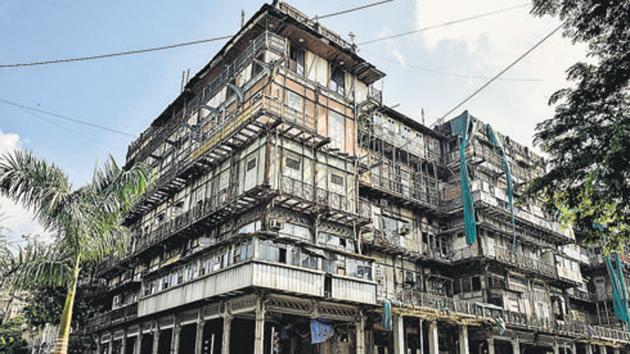A story of failed restoration plans
There are demands that the building, which was once the fashionable Watson’s Hotel, should be saved. The building is an important architectural landmark.
In 2006, the World Monuments Watch, which is an index of buildings, monuments and sites that are threatened by neglect, vandalism or natural disasters, included Mumbai’s Esplanade Mansion in its list.

The World Monuments Fund (WMF) list is less known compared to the United Nations Educational, Scientific and Cultural Organization (Unesco) directory, which includes the Victorian Gothic and Art Deco Ensembles, centred around Oval Maidan, the Elephanta Caves and the Chhatrapati Shivaji Maharaj Terminus. But the WMF list also includes more distinguished entries from India, like Kolkata’s colonial Dalhousie Square (BBD Bagh) and Delhi’s Lutyens’ bungalow zone.
The WMF entry in the endangered list was the first major alarm call to save the building. In 2009, the Mumbai Housing and Area Development Authority (Mhada), declared the building ‘dangerous’. After this and several warnings from the municipal corporation, which was ignored by the building’s owners and residents, Mhada is now forcing them out.
The building’s fate is undecided. A report from Indian Institute of Technology – Bombay, which inspected the structure, says that the cast-iron frame is irreparably damaged and the building will have to be demolished. The building’s tenants are hoping that it can be repaired. The municipal corporation will discuss the options in a meeting with the Mumbai Heritage Conservation Committee (MHCC) — as the building is on the city’s heritage list — this week.
There are demands that the building, which was once the fashionable Watson’s Hotel, should be saved. The building is an important architectural landmark.
It was built between 1867 and 1871 in wrought iron, sections of which were cast in English foundries and shipped to be assembled at the site. When it opened to guests, it was the most fashionable hotel in the city with a grand ballroom and gilded balustrades. In 1896, the hotel hosted the first screening of the Lumiere brothers’ cinematograph invention in India and writer Mark Twain is reported to have stayed here.
The hotel lost its glamour after the death of its founder John Watson and the building is reported to have been bought by the Tata Group who sold it to the present owners in the 1970s. By the 1960s, the hotel had closed down and the luxurious rooms were partitioned into residences and commercial spaces, many of them not bigger than cubbyholes.
The complex ownership structure of the building — with the owner, tenants and sub-tenants — has been a hurdle in the plans to restore it, with the government, owner and tenants rarely agreeing on what needs to be done.
The building, which has rent-protected tenancy like many properties in south Mumbai, is a ‘cessed’ structure, which means that residents pay towards a repair fund maintained by Mhada.
There were other issues that stalled restoration. The building has a Grade II A listing under urban heritage rules because of its unique construction and history. The listing means that no changes can be made to its facade and damaged sections cannot be replaced, but only repaired with original construction material.
In 2010, Mhada, which was repairing the building, stopped the work because sections of the metal frame were damaged so badly by seepage of sewage and rainwater that it was beyond repairs. The agency has to ask for permission from the MHCC to replace the wrought iron with steel frames.
A Mhada official had told this journalist that the metal frames in the south side of the building had to be replaced but they could not find replacements. “It is not possible to replace the damaged sections in the building’s south side with the same material because nobody makes this kind of wrought iron pillars anymore,” the official had said.
Around the same time, the owner and the resident, sceptical of Mhada’s expertise in restoring a heritage structure, went to private conservation agencies.
They were told that the work could require around ₹8 crore. Shocked by the cost, the residents and owner abandoned the plan.




